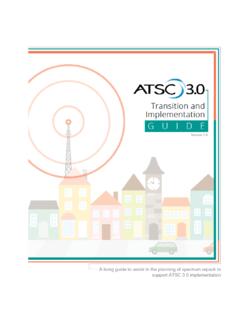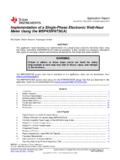Transcription of Guide to Implementation - World Health …
1 Guide to ImplementationA Guide to the Implementation of the WHO Multimodal Hand Hygiene Improvement Strategy Guide TO IMPLEMENTATION2 DEFINITION OF TERMS 4 KEY TO SYMBOLS 5 PART OVERVIEW ABOUT HAND HYGIENE IN Health CARE Rationale for a Guide to The problem of Health care-associated infections and the importance of hand A global response to the ABOUT THE Guide TO Implementation Purpose of the Guide to WHO MULTIMODAL HAND HYGIENE IMPROVEMENT STRATEGY The strategy The Implementation The step-wise approach PART SYSTEM CHANGE System change definitions and overview Tools for system change tool descriptions Using the tools for system change examples of possible situations at the Health -care setting TRAINING AND EDUCATION Training and education definitions and overview Tools for training and education tool Using the tools for training and education examples of possible situations at the Health -care setting levelCONTENTSWHO/IER/ rights reserved.
2 Publications of the World Health Organization can be obtained from WHO Press, World Health Organization, 20 Avenue Appia, 1211 Geneva 27, Switzerland Tel: +41 22 791 3264; Fax: +41 22 791 4857; E-mail: Requests for permission to reproduce or translate WHO publications - whether for sale or for non-commercial distribution should be addressed to WHO Press, at the designations employed and the presentation of the material in this publication do not imply the expression of any opinion whatsoever on the part of the WHO concerning the legal status of any country, territory, city of area or of its authorities, or concerning the delimitation of its frontiers or boundaries. Dotted lines on maps represent approximate border lines for which there may not yet be full mention of specific companies or of certain manufacturers products does not imply that they are endorsed or recommended by the WHO in preference to others of a similar nature that are not mentioned.
3 Errors and omissions exception, the names of proprietary products are distinguished by capital reasonable precautions have been taken by the WHO to verify the information contained in this publication. However, the publisher material is being distributed without warranty of any kind either expressed or implied. The responsibility for the interpretation and use of the material lies with the reader. In no event shall the WHO be liable for damages arising from its TO EVALUATION AND FEEDBACK Evaluation and feedback definitions and overview Tools for evaluation and feedback tool Using the tools for evaluation and feedback examples of possible situations at the Health -care setting REMINDERS IN THE WORKPLACE Reminders in the workplace definitions and overview Tools for reminders in the workplace tool Using the tools for reminders in the workplace examples of possible situations at the Health -care setting INSTITUTIONAL SAFETY CLIMATE Institutional safety climate definitions and overview Tools for institutional safety climate tool Using the tools for institutional safety climate
4 Examples of possible situations at the Health -care setting levelPART PREPARING AN ACTION PLAN IMPLEMENTING THE STEP-WISE APPROACH Step 1: facility preparedness readiness for Step 2: baseline evaluation establishing knowledge of the current Step 3: Implementation introducing the improvement Step 4: follow-up evaluation evaluating the Implementation Step 5: ongoing planning and review cycle developing a plan for the next 5 yearsAPPENDIX USEFUL WEBSITES 47 DISCLAIMER 47 HUG ACKNOWLEDGEMENT 47 Guide TO IMPLEMENTATION4 DEFINITION OF TERMSA ction planA detailed, carefully-prepared scheme of activities to be initiated or continued in order to improve hand hygiene at a given Health -care handrubAn alcohol-containing preparation (liquid, gel or foam) designed for application to the hands to reduce the growth of microorganisms.
5 Such preparations may contain one or more types of alcohol with excipients, other active ingredients and / efficaciousThe (possible) effect of the application of a hand hygiene formulation when tested in laboratory or in vivo / effectiveThe clinical conditions under which a hand hygiene product has been tested for its potential to reduce the spread of pathogens, field cleansingActions to prevent skin hygieneA general term referring to any action of hand hygiene co-ordinatorThe person at a facility assigned to coordinate the preparation and Implementation of the hand hygiene improvement an antiseptic handrub to reduce or inhibit the growth of microorganisms without the need for an exogenous source of water and requiring no rinsing or drying with towels or other hands with plain or antimicrobial soap and care-associated infection (HCAI)
6 An infection occurring in a patient during the process of care in a hospital or other Health -care facility which was not present or incubating at the time of admission. This includes infections acquired in the hospital but appearing after discharge, and also occupational infections among staff of the TO IMPLEMENTATION5 KEY TO SYMBOLSThe following symbols are used throughout the Guide to Implementation as a quick reference for users. The symbols highlight specific actions, key concepts and also reference the tools and resources available as part of the suite of materials available to aid Implementation . ToolsIndicates a section of the Guide to Implementation where explanations on the tools included in the Implementation toolkit are ActionIndicates a section of the Guide to Implementation where key actions for the Implementation of the WHO multimodal hand hygiene improvement strategy are pointed ConceptAlerts the reader to an issue of importance for OVERVIEW Health care-associated infection (HCAI) places a serious disease burden and has a significant economic impact on patients and Health -care systems throughout the World .
7 Yet good hand hygiene, the simple task of cleaning hands at the right times and in the right way, can save lives. World Health Organization (WHO) has developed evidence-based WHO Guidelines on Hand Hygiene in Health Care to support Health -care facilities to improve hand hygiene and thus reduce HCAI. This Guide to Implementation has been developed to assist Health -care facilities to implement improvements in hand hygiene in accordance with the WHO Guidelines on Hand Hygiene in Health Care. The strategy described in this Guide to Implementation has been designed to be used by any Health -care facility, irrespective of the level of resources or whether the facility has already implemented any hand hygiene initiatives. The approach focuses primarily on improving hand hygiene compliance by Health -care workers who work with patients.
8 Through the actions proposed by the strategy, improvement of infrastructures for hand hygiene along with enhancement of knowledge and perception about hand hygiene and HCAI and of the patient safety climate is also meant to be achieved. The ultimate goal is to reduce both the spread of infection and multi-resistant germs as well as the numbers of patients acquiring a preventable HCAI, and thus to prevent waste of resources and save of all of the tools supplied to support successful Implementation of a hand hygiene improvement strategy at any Health -care facility are provided in this Guide . ABOUT HAND HYGIENE IN Health Rationale for a Guide to ImplementationThe WHO Guidelines on Hand Hygiene in Health Care present the evidence base for focusing on hand hygiene improvement as part of an integrated approach to the reduction of HCAI.
9 Implementation is of utmost importance to achieving an impact on patient safety and therefore this Guide aims actively to support the use of the The problem of HCAI and the importance of hand hygieneHCAI affects hundreds of millions of people worldwide and is a major global issue for patient safety. At both the level of the country and of the Health -care facility, the burden of HCAI is significant, although it may be difficult to quantify at this stage. In general, and by their very nature, infections have a multifaceted causation related to systems and processes of Health -care provision as well as to political and economic constraints on Health systems and countries. They also reflect human behaviour conditioned by numerous factors, including education.
10 However, acquisition of infection, and in particular cross-infection from one patient to another, is in many cases preventable by adhering to simple practices. Hand hygiene is considered to be the primary measure necessary for reducing HCAI. Although the action of hand hygiene is simple, the lack of compliance among Health -care workers continues to be a problem throughout the World . Yet hand hygiene improvement is not a new concept within Health care. Many Health -care facilities around the World already have well-established policies and guidelines and undertake regular training programmes in this area. Increasingly, actions are being undertaken to introduce alcohol-based handrubs at the point of care. However, long-lasting improvements remain difficult to sustain, and many facilities worldwide have not yet begun to address hand hygiene improvement in a systematic way.














